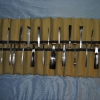When only a really, really smooth surface will do, you have to move beyond the facets left by gouges to sanding.
Sanding is not an easy option! It's difficult to do really well, especially with a complicated piece of carving; it's tedious; it produces unhealthy dust that you need to protect yourself against; and, if you are not careful, it tends to wear your fingers away. Still, it has it's place so let me show you the best way to go about it.
And before that, let me cut the sanding time down for you by telling you about woodcarvers' scrapers. These are quite different for cabinet scrapers and very effective.
There's another lesson on woodcarvers scrapers here.

| 16 April 2024 08:02
William - In a way, burnishing is indeed part of normal carving: the heel on the bevel follows through on a cut (with a really sharp gouge) and downwards pressure on the compresses the fibres, which leaves a lovely polished surface; one that doesn't need anything more.
Burnishing as an overall technique with, say, a burnishing tool, is not one used in normal, classical carving. Sometimes, however, there may be a little roughness from odd grain - say in a thumbnail moulding - and a carver may rub the heel of the blade that cut the thumbnail to flatten them, like a burnishing tool.
Burnishing is just compressing, flattening fibres; they can expand later with a change in humidity. It's not the same as cutting, scraping or sanding.
Having said all that, do experiment and if you find something that works for you, it works for you!

| 15 April 2024 17:45
Chris, do classical woodcarvers use "burnishing" to get smoother surfaces. I gather that spoon carvers often use a burnisher to press the fibers down and flatten out gouge or knife marks. In my (novice) carvings I've been using a wooden spoon to burnish the backgrounds or other parts of the carving, but the fact that you don't mention this technique makes me wonder if it is used at all by classical carvers. Thanks!

| 07 August 2023 23:58
I really love the effect of a cutting a number of gouge tracks in a piece of wood with a very sharp tool, and then adding two or three coats of varnish, which I then polish with rhinestone.

| 19 January 2016 01:37
William - Not sure I understand you here. Surfaces 1 in this series - and indeed almost every project on this site ends in a hand tooled finish. And 'selective sanding'? I hope I'm making the point that the carver must make choices over the surface finish, and ask questions about the impact of various finishes on their work. Sanding is a choice, has a certain effect. Selecting to sand a part, in a certain way, or the whole thing are also choices. I don't have hard and fast rules to give you, so much depends on what you are carving and your personal preferences - though I hope you see me making decisions about surface finishes all over Woodcarving Workshops. It's up to you really.

| 27 December 2014 15:32
Dermot - I'm sure you gathered that, for me, sanding is a choice, as much as any way of finishing your carving is a choice. As with all choices (actions), there are costs and benefits. I get such joy out of using carving tools and love the finishes I get straight off the chisel that sanding never really gets a look in! And I love the fact that I can walk away from a carving and say, 'Done!' without having to put on a dust mask. But's sanding is there as an occasional option - usually for a part of a carving, such as the pelican bill or snail shell projects here on Woodcarving Workshops

| 27 December 2014 09:46
Chris, The sanding explanation is great.
You can get Micro-Mesh papers now too that are really fine, flexible quiet durable.
Although sanding has it's place, I can see the downside to sanding exactly as you explain it, tedious and time consuming. I used it because of lack of sharpening skills.
I came to your site to learn to sharpen as I want that sharp tool finish characteristic with carving.
Cuts That Count
http://www.woodcarvingworkshops.tv/videos/techniques/cutting-to-the-chase-x5/cuts-that-count
Thanks, Dermot

| 08 August 2013 16:57
I did not know you could make and use stiff scrapers, I have only used the flexible ones.

| 18 April 2013 19:08
LOL! Ending with the chuckle is just right, sanding can be such a bore. The series is helpful as I will sand less and carve more to finish surfaces. Thanks!